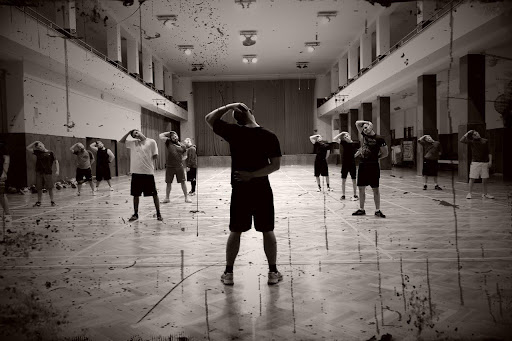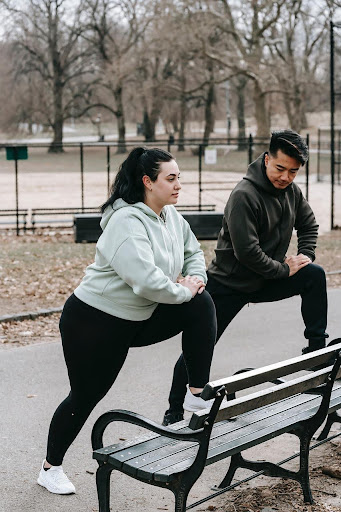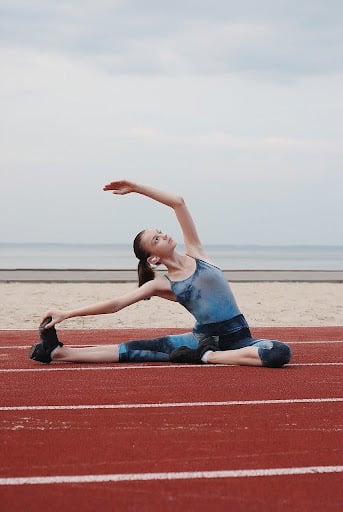Your exercise experience will be more enjoyable if you engage in a warm up and let your body cool down while moving. At the start of your workout, your muscles are cold. They may be tight from a previous workout. To avoid injury, you want to warm up those muscles and get your heartrate up. Once you’ve completed your workout, you want to slow down your heart rate and stretch as your muscles cool to avoid stiffness or cramping. Including proper warm-up and cool-down periods ensures your body transitions safely between intense exercise and recovery.
Benefits of a Good Warm Up
Warming up prepares your body for physical activity by allowing your muscles to fully oxygenate. During your warm up, your blood vessels expand and your body can move oxygen to those muscles more efficiently. Getting your lungs into the loop will help you build new muscle tissue at the height of your workout.
A good warm up will also protect your joints. The ligaments and tendons that make up the connections within your joints need to be fully oxygenated. Your warm up is an ideal time to check in with joints that may be sore from a previous activity. As you work the joint in your warm up, that soreness may abate.
A sore joint may benefit from a light stretch at the end of your warm up. You may also need to modify the intensity of your workout to avoid damaging a sore joint. Checking in with your body with a little stretching at the end of your warm up will help you avoid overloading a sore muscle or joint.

Methods for Warming Up
Consider your warm up as the junior varsity activity of your workout. If you run during your workout, walk for two minutes and do some light jogging for the next eight minutes for a solid 10 minute warm up. As you walk, swing your arms. After a lap of light jogging, stop and do 10 wall planks, then do some giant swings to fully loosen up your shoulders.
For those who lift weights as part of their workout, it’s important to start with a core warmup. For example, you might choose to bicycle to the gym. A slow cycle of easy pedaling will:
- Warm up your leg muscles
- Loosen your knees
- Work your ankles
- Engage your core
Even on an electric bike, you can strengthen your core with a gentle ride. Once you get to the gym, you’ll be ready to warm up your upper body. In addition to swinging your arms as you walk or jog, you can grab a basketball and bounce the ball off the wall to get you hands and arms moving. Checking out a racquet and hitting a tennis ball off the wall for a few minutes is a great way to warm up your entire body, including your heart. Jumping jacks can also get your whole body warm before you lift.
Once you’re warm, stretch. Those who lift weights need to get in the habit of doing some deep chest stretches. It’s also a great idea to stretch out your upper back before you lift. If you target specific muscle groups on specific days, make sure that those muscles get the most thorough warm up.
Warming Up is More Important As You Age
A hard workout can lead to soreness for young muscles that haven’t had the chance to warm up. Older athletes can suffer serious harm, including muscle strain, ligament damage and tendon tears if they don’t start with a warm up.
For older athletes, starting with a gentle version of an action may be the best choice. For example, a terrific pickleball warm up includes short side to side movements to warm up ankles, knees and hips. Gentle arm sweeps will get your wrists, elbows and shoulders ready to play.
As you move from side to side, it’s also a good idea to do some lunges or body weight squats and stretch your low back. Any sport that involves twisting and reaching can be tough on your spine. Building a strong core with lunges can help, but mini-lunges can loosen up the muscles along the spine to avoid a tear or strain.
Stay Warm Once You Get Warm
If you prefer to exercise outside, it’s critical that you stay warm once you get warmed up. You may enjoy playing pickup basketball. If you spend a bit of time on the bench, stretch while you wait. Keep the blood flowing to those warmed up muscles.
Similarly, it’s a great idea to layer up your clothing. Runners who get outside during the coldest winter months may choose to avoid wearing a coat and layer up with fleece tights under wind pants and jacket. As your run progresses, you may choose to unzip the top layer to allow perspiration to cool your skin.

Hydrate Through Your Warm Up, Workout and Cool Down
Staying hydrated is key to health overall and healthy exercise in particular. When dehydrated, your muscles can cramp. You can lose flexibility over time and struggle to stretch out serious cramps.
Dehydration can also increase your risk of soreness after a workout. Delayed onset muscle soreness, or DOMS, can quickly derail your exercise goals. Proper hydration, paired with a proper cool down and thorough stretching, can help you stick to your workout plan over time.
When you work out in cool weather or in a cool pool, it can be hard to notice that you need water. Get in the habit of carrying a water bottle and drinking at regular intervals to avoid the dangers of dehydration.
Cooling Down Effectively
Your cooldown routine is just as important as your warm up, especially if your exercise routine is intense. If possible, cool down with a buddy. The ability to talk is a good indicator of your slowing heart rate and respirations. If you can’t talk, you’re not ready to fully cool down.
Hydrate as you cool down. Some prefer a protein drink, but water is effective as well. You may also choose to drink something that offers electrolyte replacement.
As you cool down, continue to use your muscles. For example, you can keep swinging your arms as you walk or jog. If you’re on a track, you may choose to stop and stretch your quads, calves and hamstrings before continuing your circuit. Allow your muscles to loosen and relax as you go.
Effective cooldown exercises might include slow jogging or walking combined with dynamic stretches. Static stretches, held for 30 seconds, are also essential for relaxing tight muscles.
Breathe Deeply
Deep breathing, sometimes called belly breathing, is critical to an effective workout and cool down. To properly belly breathe, you need to relax the rectus abdominis, or the big muscle that runs from your ribs to the top of your pelvis. As it relaxes, your tummy expands while the diaphragm contracts, giving your lungs loads of air and room.
Many people struggle to belly breathe. They may find that their tummy draws in tight when they inhale and that their shoulders rise or their chest swells. Learning to release the rectus abdominis takes practice.
If you find that your stomach draws in when you take in a deep breath, try the following exercise:
Before you workout, lay down flat on your bed or on the floor. Place a book over your navel. Slowly take a deep breath through your nose and let the book rise toward the ceiling. As you exhale, let the book fall back toward your spine. Practice letting your tummy expand as you breathe in, rather than pulling it tight. You can also practice this in the pool as part of your cool down if you’re a swimmer.
Breathe As You Stretch
The final step of a proper cool down is to breathe deeply as you stretch. Don’t rush the process of stretching; if you have to shorten anything in your workout due to time constraints, shorten the intense portion of your workout.
Flexibility and stretching should never hurt. Get in the habit of static stretching; that is, stretch until the muscle feels taut and hold the pose for 30 seconds to get the best benefit from the stretch. Count and practice your breathing as you stretch.
Be ready to get on the floor for some stretching poses. Take your time and move slowly, especially if you’re recovering from a strain or another injury. Make sure you also stretch across the body. For example, if you struggle with shin splints and have a lot of calf pain, you can reduce it by crossing over the traditional quadricep stretch.
Stand arm length from the wall and brace yourself with your left hand. Pull the right foot toward your bottom with your right hand to stretch the quadricep and the front of the right calf. The higher your foot and the further from your bottom, the more intense the stretch. Now switch hands but keep stretching by grasping the right foot. Don’t go for height; you may put too much pressure on the knee. Instead, feel the deep stretch across the front of the right calf.

Consider Getting in the Pool
Cooling down in the pool, especially if you’re not a swimmer, may seem like an extra or unnecessary step. However, if you’re recovering from an injury or just have some wear and tear in your joints, getting in the pool can make a huge difference.
Being in the water will take the pressure off of your joints. It will also take pressure off of your spine. If you have a back injury or struggle with back pain, you may find that simple stretching movements along the wall of the pool are much less painful. You’ll enjoy a deeper stretch without discomfort.
Getting in the pool can also help you calm down your cardiovascular system. Gasping in the pool is pretty tough. Getting into deep water and walking or jogging in the pool can help you reduce the intensity of your workout and take weight off your joints.
If your workout is hard enough to cause a serious elevation in your body temperature, getting in the water can help you lower it. Take your water bottle with you to the edge of the water and keep drinking as you walk, jog slowly or stretch. Extend your body as you cool it off and work your way up to the short end of the pool, stretching your upper body as you go.
A Word About Lactic Acid
It’s almost impossible to completely avoid a build-up of lactic acid after a workout. However, an effective cool down can help. If you push yourself hard to the end of your workout session and drink a bottle of water as you drive home, you’re going to suffer a greater lactic acid build-up than if you cooled down and stretched properly.
Lactic acid is a waste product. Staying hydrated during your workout and cool down will help you shed it effectively. Letting your body temperature return to normal with a gentle cool down and focused stretching will increase the dissipation of lactic acid and reduce your risk of soreness tomorrow.
Making time for a warm up and cool down is critical to maintaining an effective workout routine. Book-ending any workout with 10 minutes of warming up and 10 minutes of cooling down will reduce the risk of injury and muscle soreness.


